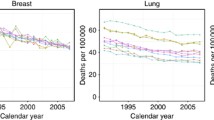Summary
In order to project trends in mortality from 11 major cancer sites in Switzerland to the end of the current century, a log-linear Poisson age/period/cohort model with arbitrary constraints on the parameters was used, fitted to the observed rates for the period 1950–84. One projection was based on the assumption of a total absence of change in the effect of period, the second was based on a linear extrapolation of the logarithms of the seven known periods, and the third was related to a series of a priori external epidemiological hypotheses, whenever available. For instance, coefficients below unity were used for lung and other tobacco-related neoplasms in men, since some decline in exposure to tobacco carcinogens was observed among Swiss men, and above unity for women since the prevalence of smoking has risen among successive generations of women. Although the method has limitations and uncertainties, several qualitative indications could be derived from this exercise. For instance, the various models suggest that the age-standardized mortality from oral cancer in men will probably increase up to the end of the century, even under the optimistic assumption of an appreciable decline in smoking, while cancer of the oesophagus is likely to level-off around current values, as other tobacco-related neoplasms, prostate cancer in men, and breast cancer in women will probably do. Some steady decline is predicted by various models fitted to the incidence of stomach and intestinal cancer in both sexes, and to ovarian cancer. Lung cancer will continue to rise in women but will stop rising in men, and it will possibly fall if the hypothesis of a decline in exposure to tobacco carcinogens proves correct. Although any prediction has, by definition, substantial difficulties and uncertainties, projections of cancer mortality in the near future are based on a substantial amount of information already available, and may offer valuable information for epidemiological inferences and health planning purposes.
Similar content being viewed by others
References
Baker RJ, Nelder JA (1978) The GLIM system. Release 3. Numerical Algorithms Group, Oxford, England
Boyle P, Robertson C (1987) Statistical modelling of lung cancer and laryngeal cancer incidence in Scotland, 1960–1979. Am J Epidemiol 125:731–744
Boyle P, Robertson C (1989) Statistical modelling of lung cancer and laryngeal cancer incidence in Scotland, 1960–1979. Am J Epidemiol 129:225–226
Brown CC, Kessler LG (1988) Projections of lung cancer mortality in the United States: 1985–2025. J Natl Cancer Inst 80:43–51
Clayton D, Schifflers E (1987) Models for temporal variation in cancer rates: age-period, age-cohort models. Stat Med 6:449–467
Day NE (1983) Time as a determinant of risk in cancer epidemiology: the role of multi-stage models. Cancer Surv 2:577–593
Decarli A, La Vecchia C (1987) Age, period and cohort models: review of knowledge and implementation in GLIM. Riv Stat Appl 20:397–408
Doll R, Peto R (1978) Cigarette smoking and bronchial carcinoma: dose and time relationships among regular smokers and lifelong nonsmokers. J Epidemiol Community Health 32:303–313
Early Breast Cancer Trialists' Collaborative Group (1988) Effects of adjuvant tamoxifen and of cytotoxic therapy on mortality in early breast cancer. N Engl J Med 319:1681–1692
Hakulinen T, Pukkala E (1982) Prediction of cancer incidence by utilization of risk factors and the effect of intervention. In: Magnus K (ed) Trends in cancer incidence: causes and implications. Hemisphere Publ Corp, Washington, pp 111–123
La Vecchia C, Decarli A, Fasoli M, Franceschi S, Gentile A, Negri E, Parazzini F, Tognoni G (1986a) Oral contraceptives and cancers of the breast and of the female genital tract. Interim results from a case-control-study. Br J Cancer 54:311–317
La Vecchia C, Decarli A, Parazzini F, Gentile A, Liberati C, Franceschi S (1986b) Non-contraceptive oestrogens and the risk of breast cancer in women. Int J Cancer 38:853–858
La Vecchia C, Levi F, Decarli A, Wietlisbach W, Negri E, Gutzwiller F (1988) Trends in smoking and lung cancer mortality in Switzerland. Prev Med 17:712–724
Levi F, La Vecchia C, Decarli A, Randriamiharisoa A (1987) Effects of age, birth cohort and period of death on Swiss cancer mortality, 1951–1984. Int J Cancer 40:439–449
Levi F, Decarli A, La Vecchia C, Randriamiharisoa A (1988a) Krebssterblichkeit in der Schweiz, 1950–1984. — La mortalité par cancer en Suisse, 1950–1984. —Cancer mortality in Switzerland, 1950–1984. Bern, Bundesamt für Statistik/ Lausanne, Institut universitaire de médecine sociale et préventive. (Amtliche Statistik der Schweiz, Nr. 165)
Levi F, Decarli A, La Vecchia C, Randriamiharisoa A (1988b) La mortalité par cancer en Suisse entre 1951 et 1984: effets de l'âge, de la génération et de la période de décès. —Cancer mortality in Switzerland, 1951–1984: effects of age, birth cohort and period of death. Schweiz Med Wochenschr 118 (suppl 26):7–85
Osmond C (1985) Using age, period and cohort models to estimate future mortality rates. Int J Epidemiol 14:124–129
Osmond C, Gardner MJ (1982) Age, period and cohort models applied to cancer mortality rates. Stat Med 1:245–259
U.S. Department of Health and Human Services (1982) The Health consequences of smoking: cancer. A Report of the Surgeon General of the Public Health Service, U.S. G.P.O., Washington,DC
Author information
Authors and Affiliations
Rights and permissions
About this article
Cite this article
Negri, E., La Vecchia, C., Levi, F. et al. The application of age, period and cohort models to predict Swiss cancer mortality. J Cancer Res Clin Oncol 116, 207–214 (1990). https://doi.org/10.1007/BF01612679
Received:
Accepted:
Issue Date:
DOI: https://doi.org/10.1007/BF01612679




